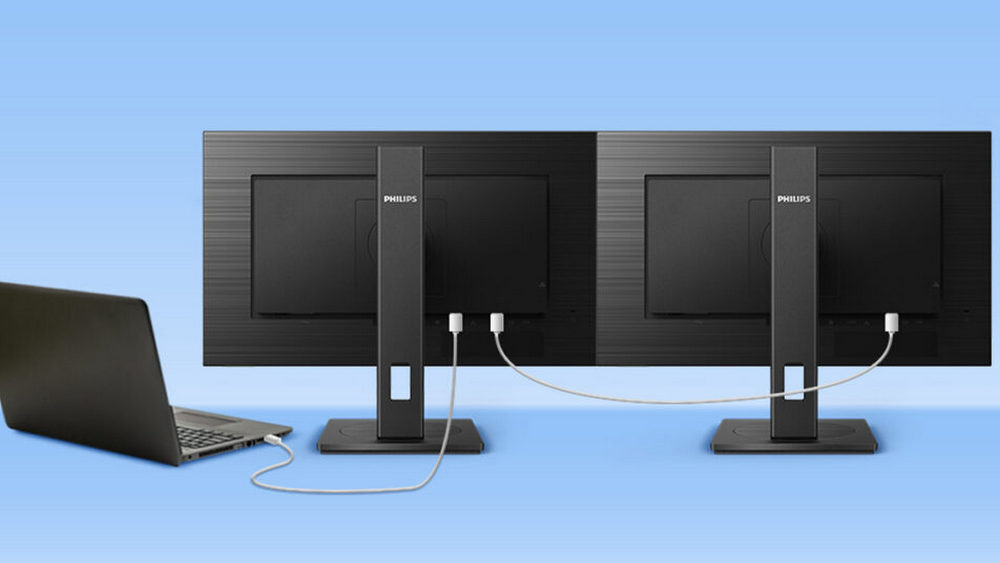![]() 2023/06/06 | MMDInnovationHub
2023/06/06 | MMDInnovationHub
Screen sizes matter, and users can either upgrade to bigger monitors or create multi-monitor set-ups that can reflect and support their needs. More screen real estate mimics our own natural view better and so makes the visualization more comfortable. But having more space means that professionals can have more documents, apps and media displayed at the same time, with less toggling through programs, less switching through documents. Seeing the “big picture” is not only important and more comfortable but can also definitely improve productivity!
Although creating a multi-monitor set up might sound scarily like a huge tangle of wires (and according to a survey, 41% of those surveyed think that a tidy desk is key in enhancing productivity[1]), it can be easy, hassle-free and almost wires-free. The solution is daisy chaining: the ability to daisy chain multiple displays enables you to maintain a clean desktop without the hassle of too many wires.
To enable daisy-chain you only need a GPU (or VPU) that supports DisplayPort 1.2 MST (and then can simultaneously process multiple displays) and two or more monitors that have both DP in and out.
The best monitor for daisy chain? The Philips 40B1U5601H offers the easy connectivity of USB-C technology, the superb picture quality of UltraWide QHD resolution with DisplayHDR, the convenience of MultiClient Integrated KVM to control two PCs with one monitor-keyboard-mouse set up, and even an integrated 5 MP webcam, making them the ideal choice for dynamic professionals who want to make 2023 their most productive year ever. This model offers DisplayPort out, to connect multiple high-resolution displays with just one cable from your first display to the PC.

How does daisy chaining work?
Daisy-chaining monitors means connecting multiple monitors to each other and then to a single computer, using a DisplayPort cable to connect monitor to monitor, rather than connecting each monitor to the graphics board of the single computer or laptop in use. “Daisy chaining” so means that only one monitor needs to be connected to the computer.
Daisy chaining is also really easy to set up. These are the steps to follow:
1. Verify that the video or graphics card (VPU or GPU) on your laptop/PC supports DisplayPort 1.2 MST. 2. Connect your first monitor’s DisplayPort In to the laptop or PC in use. 3. Connect the DisplayPort Out of the first monitor to DisplayPort In of the second monitor. To daisy-chain more monitors, you just have to follow the same steps: you can then daisy-chain a third monitor into the second, a fourth into the third and so on. 4. Lastly, adjust your display settings. You can choose between two main options for “DP Out Multi-Stream”: “Clone” or “Extend”. Extending all three screens allows you to have a seamless display space.The process is almost identical using Thunderbolt 3. You should:
1. Verify that the video or graphics card (VPU or GPU) on your laptop/PC supports DisplayPort 1.2 MST. 2. Connect your first monitor to the laptop or PC in use using a Thunderbolt cable. 3. Connect the first monitor to the second monitor using a Thunderbolt cable. You can then daisy-chain multiple monitors. 4. Lastly, adjust your display settings. You can find a video explaining the whole process step-by-step here.What is the benefit of daisy chaining?
There are many benefits: daisy chaining reduces clutter on the desk, making the workstation free and neat, but also simplifies cable management, reducing the amount of cabling required to operate a complex multi-monitor set-up. Laptop-users would particularly benefit from this set-up, due to the limited outputs of recent laptops and small-PCs. Generally, monitor connection becomes much quicker, allowing professionals to immediately enjoy the extra screen space of multi-monitor setups.
Can you daisy chain USB-C monitors?
You can’t exactly daisy-chain via USB-C, but you can if the two monitors have a DisplayPort out or Thunderbolt 3. These two are necessary to enable daisy chaining, up to now.
However, having USB-C connectivity (or a USB-C hub) can boost your productivity even more. The Philips 40B1U5601H offers DisplayPort out, to connect multiple high-resolution displays with just one cable from the first display to the PC, and a wide array of connectivity options to meet all the needs of professionals, having a working station that can support their hours in front of the screen, and help unleash their creativity.
Can I daisy chain 2 monitors together?
Yes, all you need to daisy chain two or more monitors together is for them to have a DisplayPort in/out or Thunderbolt 3, and to have DisplayPort cables to connect the monitors. Lastly, your GPU must support DisplayPort 1.2 MST (“Multi-stream transport”).
Based on your GPU, you can daisy-chain from 3 to 6 monitors. However, there’s a limited amount of data that can be transferred through DP, and daisy-chaining more than 2 monitors might compromise the resolution of your set-up.
Does daisy chaining reduce performance?
It depends on the number of monitors you are using, and their quality. If you want to daisy chain only two displays, the performance should not be sensibly impacted.
Although extremely useful, daisy chaining multiple monitors slightly reduces the performance along the chain. It is not an abrupt and extreme reduction, but you can organize your set-up strategically. You can have the highest resolution on your primary monitor, the one to stream contents and to work on complex visual works. You can then scale down the resolution as you go down the chain and use the extra space accordingly for tasks that are less detail dependent.